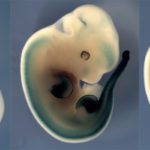Link to Pubmed [PMID] – 15226428
Mol. Cell. Biol. 2004 Jul;24(14):6253-67
Muscle fibers show great differences in their contractile and metabolic properties. This diversity enables skeletal muscles to fulfill and adapt to different tasks. In this report, we show that the Six/Eya pathway is implicated in the establishment and maintenance of the fast-twitch skeletal muscle phenotype. We demonstrate that the MEF3/Six DNA binding element present in the aldolase A pM promoter mediates the high level of activation of this promoter in fast-twitch glycolytic (but not in slow-twitch) muscle fibers. We also show that among the Six and Eya gene products expressed in mouse skeletal muscle, Six1 and Eya1 proteins accumulate preferentially in the nuclei of fast-twitch muscles. The forced expression of Six1 and Eya1 together in the slow-twitch soleus muscle induced a fiber-type transition characterized by the replacement of myosin heavy chain I and IIA isoforms by the faster IIB and/or IIX isoforms, the activation of fast-twitch fiber-specific genes, and a switch toward glycolytic metabolism. Collectively, these data identify Six1 and Eya1 as the first transcriptional complex that is able to reprogram adult slow-twitch oxidative fibers toward a fast-twitch glycolytic phenotype.

